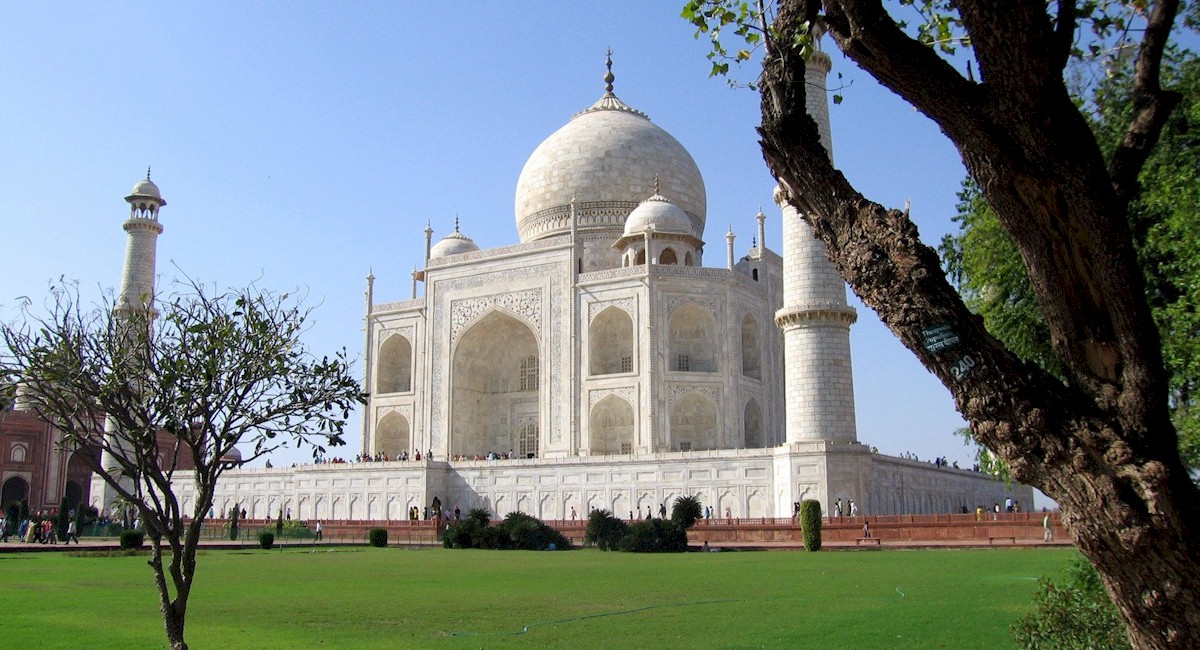
Taj Mahal
Undoubtedly one of Agra’s most popular attractions,
the Taj Mahal is not just famous in India but is a
monument renowned across the world. Built by Mughal
Emperor Shah Jahan for his deceased wife Mumtaz, it is
emblematic of the emperor’s deep love for his wife and
the grief he experienced at her passing. A landmark
monument and a UNESCO World Heritage Site, the Taj Mahal
is one of the most admired Mughal masterpieces in the
world and is nothing short of poetry crafted in marble.
The architect of the Taj Mahal was Ustad Ahmed Lahauri
and the design is representative of Indian, Persian and
Islamic styles of architecture. It took 21 years for the
Taj Mahal to be constructed (from 1632 to 1652) with
over 20,000 labourers working night and day.
Described as a “teardrop on the face of eternity” by
legendary poet Rabindranath Tagore, the Taj Mahal never
fails to impress visitors. Take a relaxed stroll through
the grounds or just sit and admire the beautiful,
reflective pools and exquisite gardens on the premises.
To truly experience its ethereal beauty, visit the Taj
Mahal early in the morning when it’s relatively quieter
and less crowded or on a full moon night when the white
marble glows against the backdrop of the dark, night
sky.
Agra Fort
Spread over a sprawling 94 acres, this massive red
sandstone fort lies parallel to the Yamuna River and is
situated 2 kilometres northwest of the Taj Mahal. The
Agra Fort was originally occupied by Sikarwar Rajputs
and was later captured by Lodi rulers of Delhi. In 1526,
after the Lodis were defeated in the Battle of Panipat,
the victor Emperor Babur took over the fort. After
losing the fort briefly to the Suri rulers, it was
eventually reclaimed by Akbar who made Agra his capital.
Akbar carried out extensive renovation of the
dilapidated fort using red sandstone, which took over
4,000 workers and eight years to complete. Agra Fort is
known for its majestic gates with the most impressive
being the Delhi Gate and Lahore Gate. Another majestic
gate is the Elephant Gate, which is situated between two
red sandstone towers. Despite the magnificence of these
gates, currently only the Amar Singh Gate is open to
visitors.
Visitors must note that there is no provision to buy
water and other bottled drinks inside the fort and it is
advised to carry water along since exploring the fort
can prove to be a long and tiring experience.
Mehtab Bagh
A garden built on the banks of Yamuna River, Mehtab
Bagh was constructed by Emperor Babur and was the last
of a series of 11 such gardens built along the east bank
of the river. Mehtab Bagh was built as an integral part
of the Taj complex as the gardens of the Taj are
perfectly aligned with Mehtab Bagh, making it the best
place to view the Taj from.
Mehtab Bagh also joins two other gardens to the west
known as the Chahar Bagh Padshshi and Second Chahar Bagh
Padshahi. Originally, four sandstone towers marked the
corners of Mehtab Bagh of which only one at the south
east edge remains. The gardens also contain a large pond
on its outer edges which reflects the image of the Taj.
Apart from water channels that enhance the beauty of the
natural scenery, there is also a small tank in the
centre of the garden. Visit Mehtab Bagh to enjoy its
broad walkways, breezy canopies, beautiful pools,
fountains and fruit trees. Mehtab Bagh provides a great
photo opportunity for shutterbugs courtesy the views of
the Taj Mahal that one can get from here.
Mariam’s Tomb
Located a kilometre north of Sikandra (a suburb of Agra) is Mariam's Tomb, the final resting place of Akbar’s wife and Jahangir’s mother, Marium-uz-Zamani Begum. Mariam’s Tomb, though largely plain, is a large sandstone structure with intricate carvings covering its outer walls. Unlike other Mughal monuments, the tomb has no domes and large chhatris top the corners of the building instead. The architecture of the tomb is a unique combination of Islamic and Hindu styles, which had gained popularity during the rule of Akbar and Jahangir. The interiors of the tomb are segmented by a grid of crisscrossing corridors and like most Mughal tombs, Mariam’s grave lies in a vault below the surface of the tomb.
Sur Sarovar Bird Sanctuary
The Sur Sarovar Bird Sanctuary is located 20
kilometres from Agra on the Delhi-Agra Highway (NH2).
Spread over an area of 7.97 square kilometres, the
sanctuary was declared a National Bird Sanctuary in
1991. Home to the beautiful man-made Keetham Lake, it is
a great place for a relaxed outing with your loved ones.
More than 106 species of migratory birds come to Sur
Sarovar every year. What's more, it is also the habitat
for birds such as the little gerb, cattle egret, purple
heron, darter, common teal and pintail, among others.
The Sur Sarovar Lake is an ideal spot for a picnic with
the kids.



